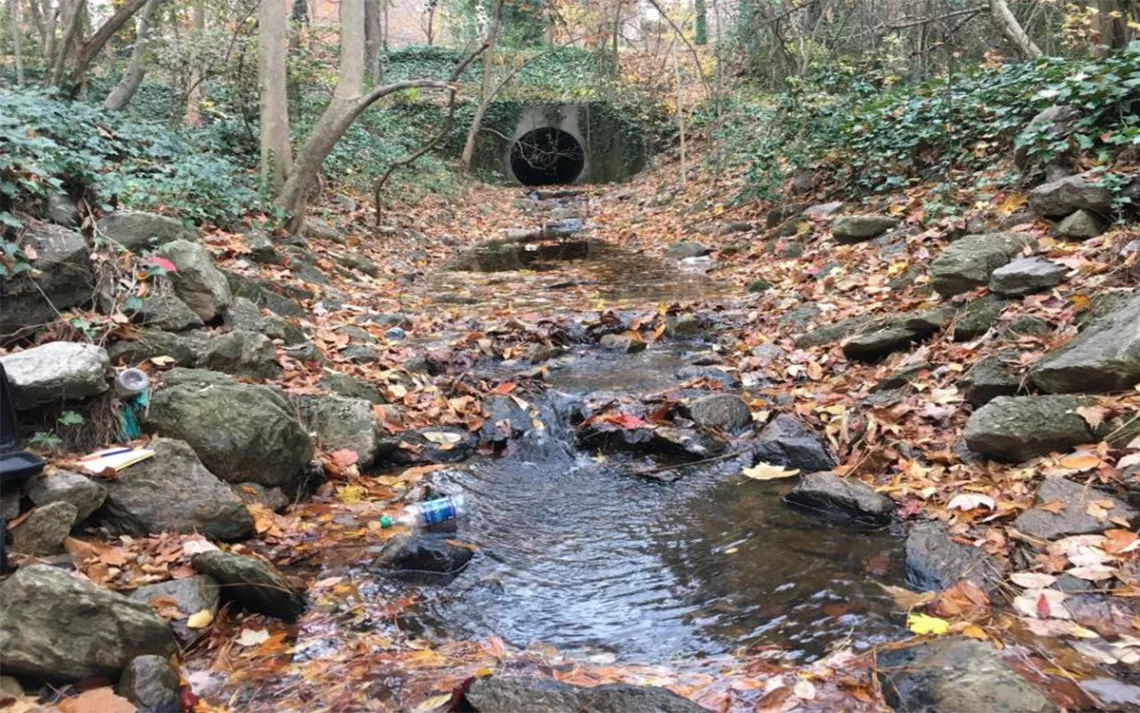Dead Zones Can Exist In Urban Streams Too
Low oxygen environments from storm runoff can impact waterway biodiversity

Photo courtesy of Duke University
Ecologists have been concerned about the expansion of hypoxic or “dead” zones in coastal waters and large lakes for decades, including an annually occurring dead zone at the mouth of the Mississippi that is now the world’s second largest. Each year, pollutants like phosphorous feed a massive algae bloom that sucks up all the oxygen, killing off fish and other organisms. Because streams and rivers flow, bringing in a constant supply of oxygenated water, hypoxia hasn’t been a concern. But a new study suggests in certain cases urban streams can suffer from oxygen deprivation as well.
In particular, Joanna Blaszczak, former grad student at Duke’s Nicholas School of the Environment and lead author of the study in the journal Limnology and Oceanographylooked at six urban streams in Durham and Raleigh, North Carolina, that also serve to channel storm water. Measuring dissolved oxygen, light levels, stream flow, and chemistry, they were able to model the growth of algae and oxygen-consuming bacteria in the streams.
What they found is that the intense rush of storm water through these streams has reshaped them down to the bedrock, creating deep pools that can trap water and stagnate. In late summer, fertilizer, animal waste, and other pollutants build up dropping oxygen levels in these pools below two-milligrams per liter, a level toxic to fish and many other creatures that live in the streams.
According to Blaszczak, researchers already knew that many urban waterways are highly stressed from pollution, high erosion rates, and alterations to their channel, but hypoxia wasn’t really on the radar. In the beginning, she was just studying the food webs in these streams when the oxygen sensors she was using showed her that the O2 in the streams was occasionally crashing. “It opened our eyes that hypoxia was going on in these streams,” she says. “We took a step back and looked at the streams, and found the ones with the lowest gradient channels with manmade pools were most susceptible since there was no freshwater moving through to re-oxygenate the water.”
It’s hard to say without more study what kind of impact the hypoxia can have on the overall health of the streams. “One day I went to a hypoxic stream and saw a couple dead fish floating,” she says. “How frequent it occurs or which organisms are able to tolerate the hypoxia we’re not entirely sure.”
Blaszczak says it’s possible that hypoxia isn’t just limited to these small urban streams but could be impacting larger waterways as well. Over a century of dam building and manmade alterations to rivers could be having similar effects that have simply not been observed, negatively impacting biodiversity.
It’s easy to dismiss the value of small urban streams or to consider them sacrificial lambs to urban expansion. But Barbara Doll, an engineer and ecological restorer at North Carolina State University who has worked on dozens of stream restoration projects says that’s a mistake. “People say, oh well, these are pointless streams, but small channels can have major impact on the water quality of rivers,” she says. “You’re not going to have trout in an urban stream, but if every stream that feeds into a bigger river is trashed and flows into waters that are really highly valuable for fisheries or drinking water that’s a problem.”
Doll has seen the same problems in streams as Blaszczak. When storm water is routed into urban streams that have been confined to small channels, they act like a firehose, blasting out material until the stream is like a small, eroded canyon. That’s not good for wildlife or fish, and can eventually begin to erode away private property. And in the case of torrential rains, those fast moving flumes of water can lead to catastrophic flooding.
Instead, urban planners and restorationists need to think about building out flood plains. “Flood plains can absorb the energy of the larger storms we’re getting with their greater volumes of water,” she says. “The more floodplain, the better. As one of my colleagues likes to say, ‘When in doubt, spread it out.’”
She also advises planting native vegetation whose deep root systems can stabilize erodible stream beds and suggests adding pools for fish habitat as well as areas of riffles that can bring oxygen into the system.
Blaszczak says that lots of attention has been paid to reducing the erosion caused by storm runoff in urban streams, but that’s not the only thing managers need to consider. “For me, the most interesting thing that came out of the study is that you have to think about what happens in these streams in between storms,” she says. “You have to think holistically to manage and protect urban streams.”
 The Magazine of The Sierra Club
The Magazine of The Sierra Club



